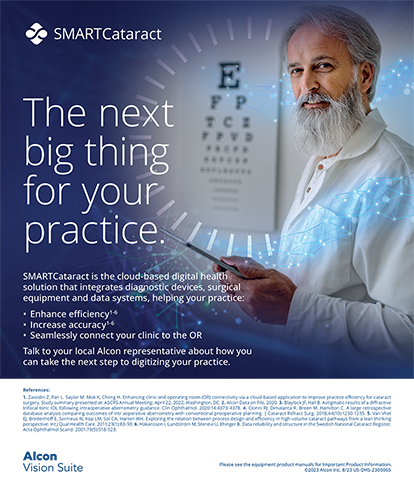As advances in technology allow cataract and refractive surgeons to address higher-order optical aberrations, measuring functional vision becomes increasingly critical as a measure of our progress. Sine wave contrast sensitivity testing is assuming a prominent place in our evaluation of surgical modalities, because it reflects functional vision, correlates with visual performance, and provides a key to understanding optical and visual processing of images. The Tecnis Z9000 IOL (Pharmacia Corporation, Peapack, NJ) is the first foldable IOL designed to correct higher-order optical aberrations, and represents the first step toward integrating wavefront technology and lens-based surgery.
CONTRAST SENSITIVITY
Although eliminating lower-order optical aberrations, near- and farsightedness, and refractive astigmatism, and thus achieving emmetropia, remain the most important targets for cataract and refractive surgeons, the goal of providing high-quality vision increasingly reflects our understanding of the visual system as a whole. Snellen acuity represents only a small portion of functional vision. Comparing vision with hearing highlights the limitations of standard visual acuity tests—the auditory equivalent of a standard high-contrast Snellen eye chart would be a hearing test with only one high level of loudness for all sound frequencies. Today, contrast sensitivity testing is emerging as a more comprehensive measure of vision that could replace Snellen letter acuity testing, in the same manner as audiometric testing replaced the “click” and spoken-word tests used prior to the 1940s.1 Sine wave gratings are the building blocks of vision, just as pure tones are the building blocks of audition.
Ophthalmologists realize that patients may complain about haze, glare, and poor night vision despite 20/20 Snellen acuity. Even patients with advanced nuclear sclerosis, despite having significant impairment of daily living, may be able to maintain acuities close to 20/20. The letters these patients perceive on the chart appear gray rather than black, and there is no way for the examiner to discern this loss of contrast.
Contrast Sensitivity Testing Versus Snellen Measurements
Contrast sensitivity testing has the ability to detect differences in functional vision when Snellen visual acuity measurements cannot.2 For example, although a patient with a loss of low-frequency contrast sensitivity may be able to read 20/20, he may be unable to see a truck in the fog. While blur due to refractive error alone affects only the higher spatial frequencies, light scatter due to corneal or lenticular opacities causes loss at all frequencies. Glaucoma and other optic neuropathies generally produce loss in the middle and low frequencies. Contrast sensitivity testing offers critical information to help explain patients' complaints.
Numerous studies have demonstrated the relationship between contrast sensitivity and visual performance. Contrast sensitivity has consistently been found to play a major role in varied circumstances such as driving difficulty3 and crash involvement,4 falls5 and postural stability in the elderly,6 activities of daily living and visual impairment,7 as well as the performance of pilots in aircraft simulators.8 Unfortunately, contrast sensitivity declines with age, even in the absence of ocular pathology such as cataract, glaucoma, or macular degeneration (Figure 1). The pathogenesis of this visual decline involves changes in spherical aberration of the crystalline lens.
SPHERICAL ABERRATION
Spherical aberration is a property of spherical lenses. A spherical lens does not refract all parallel rays of incoming light to a single secondary focal point. The lens bends peripheral rays more strongly, so that these rays cross the optical axis in front of the paraxial rays. As the aperture of the lens increases, the average focal point moves toward the lens so that a larger pupil produces greater spherical aberration.
Spherical aberration of the cornea changes little with age. However, total wavefront aberration of the eye increases more than threefold between 20 and 70 years of age.9 Wavefront aberration measurements combined with data from corneal topography demonstrate that the optical characteristics of a youthful crystalline lens compensate for aberrations in the cornea by reducing total aberration in younger people (Figure 2). Unfortunately, an aging lens no longer compensates well, as both the magnitude and the sign of its spherical aberration change significantly.10 Thus, a loss of balance between corneal and lenticular spherical aberration causes the degradation of optical quality in the aging eye (Figure 3).
It has been documented that the contrast sensitivity of a pseudophakic patient is no better than that of a phakic patient of a similar age who has no cataract development.11 For example, when a 65-year-old patient is implanted with spherical IOLs after cataract removal, the resulting visual outcome is no better than the visual quality of a 65-year-old who does not have cataracts. The fact that the visual quality of IOL patients is no better than that of their same-age counterparts is surprising, because an IOL is optically superior to the natural crystalline lens. This fact may be explained by aberrations.
The spherical aberration of a manufactured spherical IOL is in no better balance with the cornea than the spherical aberration of the aging crystalline lens. Aberrations cause incoming light that would otherwise be focused to a point to blur, which reduces visual quality. This reduction in quality is more severe under low-luminance conditions, because ocular aberrations increase with pupil size.
TECNIS Z9000
The Tecnis Z9000 IOL, currently undergoing FDA-monitored clinical trials in the US, is designed with a modified prolate anterior surface to compensate for the spherical aberration of the cornea (Figure 4). The prolate surface has a relatively steeper curvature centrally and a relatively flatter curvature peripherally, thus producing less refractive power in the peripheral area of the lens. Mark Packer, MD, is Principal Investigator for this multicenter, randomized, evaluator-masked clinical investigation now enrolling subjects at five sites. We expect to present results of this study at the AAO meeting in Orlando, Florida, later this year.
Design Features
The Tecnis Z9000 shares basic design features with the CeeOn Edge 911A (Pharmacia), including a 6-mm, biconvex, square-edge silicone optic and angulated, cap C polyvinylidene fluoride haptics. The implantation technique for the Tecnis Z9000 IOL is identical to that for the CeeOn Edge 911A. For the FDA-monitored study, the IOL is easily folded and implanted with forceps through a 3.5-mm incision. Pharmacia now has an injection system pending regulatory approval in the US. We have had the opportunity to demonstrate this device in model eyes and anticipate its success once it is available. In the meantime, many surgeons have discovered that other injection devices are capable of safely inserting CeeOn lenses through 2.5- to 2.8-mm incisions.
TECHNIQUE
The implantation technique begins with incision construction. We favor the Rhein 3-D diamond blade (Rhein Medical Inc., Tampa, FL), which allows the surgeon to construct a 2-mm X 2.5-mm, single-plane, temporal clear corneal incision. After lubricating the cartridge with viscoelastic, fold the Tecnis IOL according to the manufacturer's instructions. Take special care to properly place the clear haptics.
Cartridge Insertion
Introduce the cartridge into the anterior chamber without enlarging the incision. Touch the tip of the cartridge to the outside of the incision with the bevel down (a bevel-up position may be used in cases involving an increased risk of iris prolapse). Gently wiggle the shooter to facilitate passage of the sleeve through the incision. Once inside the anterior chamber, position the leading haptic in the capsular bag and gently unfold the IOL. Rotate the shooter counterclockwise to maintain the proper position of the IOL. Place the trailing haptic into the capsular bag by withdrawing the plunger proximally within the cartridge, contacting the trailing haptic and pushing it forward. You may need to slightly rotate the cartridge to gain sufficient traction on the trailing haptic to push it forward.
Haptic Positioning
Once the implant is in the bag, always remove viscoelastic from behind the IOL with the I/A tip. Following removal, use Miochol (Novartis New Zealand Ltd., Auckland, NZ) to constrict the iris and BSS (Alcon Laboratories, Fort Worth, TX) to seal both the paracentesis and incision with stromal hydration. We employ fluorescein to ensure a Seidel negative closure.
The principal outcome measurement for the clinical investigation consists of mesopic sine wave contrast sensitivity at six cycles per degree. The Hartmann-Shack wavefront sensor will provide information on optical aberrations postoperatively, while driving simulation studies will examine the functional benefit of this new IOL technology. Driving simulation studies have been correlated with contrast sensitivity as reported previously.12 Theoretical calculations and optical bench measurements support the hypothesis of improved contrast sensitivity with the Tecnis IOL.
Clinical data from studies in Europe comparing Tecnis with various spherical IOLs support the Tecnis concept. Ulrich Mester, MD, from Salzbach, Germany, presented data at the ASCRS Symposium in Philadelphia this year and demonstrated the statistically significant superiority of sine wave grating contrast sensitivity with Tecnis at all spatial frequencies, under both mesopic and photopic conditions.13 Roberto Bellucci, MD, and Lucio Buratto, MD, from Milan, Italy, are conducting a study that demonstrates, not only superior contrast sensitivity, but also improved perimacular threshold sensitivity with automated perimetry.
A PROMISING FUTURE
The essential new feature of the Tecnis IOL, the modified prolate anterior surface, acts like the youthful crystalline lens and compensates for corneal spherical aberration. The exciting new concept of the Tecnis has the potential for restoring youthful optical quality and improving functional vision.
I. Howard Fine, MD, is Clinical Professor, Casey Eye Institute, Department of Ophthalmology, Oregon Health and Science University, and is in private practice in Eugene, Oregon. He does not hold a financial interest in any of the products mentioned herein. Dr. Fine may be reached at (541) 687-2110; hfine@finemd.com.
Richard S. Hoffman, MD, is Clinical Instructor, Casey Eye Institute, Department of Ophthalmology, Oregon Health and Science University, and is in private practice in Eugene, Oregon. He does not hold a financial interest in any of the products mentioned herein. Dr. Hoffman may be reached at (541) 687-2110; rhoffman@finemd.com.
1. Ginsburg AP. The Evaluation of Contact Lenses and Refractive Surgery Using Contrast Sensitivity, in Contact Lenses: Update 2. Grune & Stratton, Inc., 1987, 56.5.
2. Evans DW, Ginsburg AP. Contrast sensitivity predicts age-related differences in highway sign discriminability. Human Factors. 1985;27(12):637.
3. McGwin G Jr, Chapman V, Owsley C. Visual risk factors for driving difficulty among older drivers. Accid Anal Prev. 2000;32(6):735-744.
4. Owsley C, Stalvey BT, Wells J, et al. Visual risk factors for crash involvement in older drivers with cataract. Arch Ophthalmol. 2001;119(6):881-887.
5. Lord SR, Dayhew J. Visual risk factors for falls in older people. J Am Geriatr. Soc 2001; 49(5):508-515.
6. Lord SR, Menz HB. Visual contributions to postural stability in older adults. Gerontology. 2000;46(6):306-310.
7. Rubin GS, Bandeen-Roche K, Huang GH, et al. The association of multiple visual impairments with self-reported visual disability: SEE project. Invest Ophthalmol Vis Sci. 2001;42(1)64-62.
8. Ginsburg AP, Evans DW, Sekule R, Harp SA. Contrast sensitivity predicts pilots' performance in aircraft simulators. Am J Optom Physiol Opt. 1982;(1):105-109.
9. Artal P, Berrio E, Guirao A, Piers P. Contribution of the cornea and internal surfaces to the change of ocular aberrations with age. J Opt Soc Am A Opt Image Sci Vis. 2002;19(1):137-143.
10. Glasser A, Campbell MC. Presbyopia and the optical changes in the human crystalline lens with age. Vision Res. 1998;38(2): 209-229.
11. Guirao A, Gonzalez C, Redondo M, et al. Average optical performance of the human eye as a function of age in a normal population. Invest Ophthalmol Vis Sci. 1999;40:203-213.
12. Ginsburg AP, Kelly M. Functional Vision Testing: Night Driving Simulator Studies. ASCRS ASOA Symposium of Cataract, IOL, and Refractive Surgery. San Diego, CA. April 1-5, 1995.
13. Mester U, Anterist N, Dillinger P. Improved Optical and Visual Quality With an Aspheric IOL. Symposium on Cataract, IOL, and Refractive Surgery. Philadelphia, PA. June 2002.


